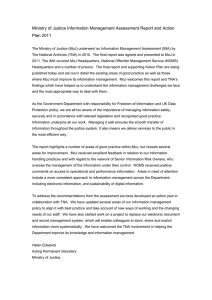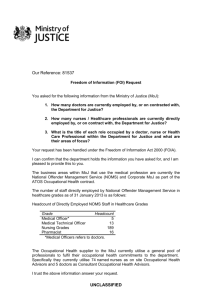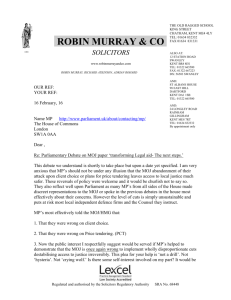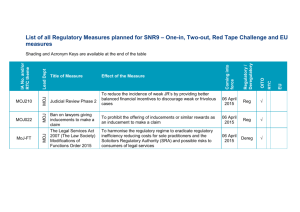Information Management Assessment Action Plan Review The Ministry of Justice
advertisement
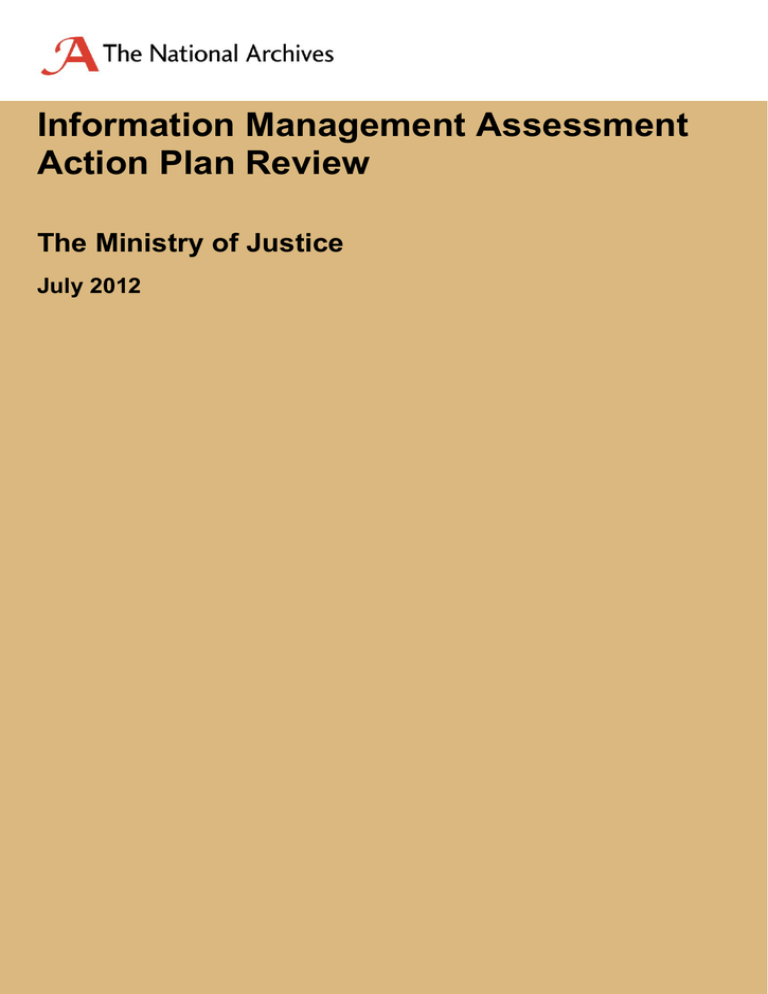
Information Management Assessment Action Plan Review The Ministry of Justice July 2012 Background The National Archives Information Management Assessment (IMA) programme is the best practice model for government bodies wishing to demonstrate commitment to the principles of good information management. In July 2010 The National Archives conducted a joint assessment covering Ministry of Justice (MOJ) HQ and the department’s largest agency, the National Offender Management Service (NOMS). An IMA report containing 34 recommendations for improvement was agreed with MOJ in July 2011 and formed the basis of a departmental action plan. In July 2012 The National Archives held a meeting to formally assess progress made since the IMA. Key findings of the 2010 IMA The IMA report rates MOJ as ‘Good’ under seven out of 20 risk headings and ‘Acceptable’ under a further eight. The report notes a commitment to enabling better sharing of information across the organisation, and to building a greater understanding of the importance of knowledge and information management among staff. MOJ’s efforts to develop a comprehensive framework of policies and guidance are commended in particular. The IMA report acknowledges the challenges that MOJ faces in creating effective corporate structures for the management of information and integrated processes, systems and culture. The report identifies five ‘Development Needed’ areas. Risks and issues highlighted include: The Knowledge and Information Management (KIM) team in MOJ HQ has a low profile and ongoing support at board level is needed. Many staff see the MOJ EDRMS, TRIM, as unreliable and use is inconsistent. Within NOMS, approved shared drives are being introduced. Clear instruction is needed on the use of corporate systems to help reduce risks to key records and the corporate memory. Staff do not always recognise the corporate nature of the information they hold. The implementation of a ‘What to Keep’ approach would provide necessary clarity. 1 Prison NOMIS has the potential to bring greater consistency to the management of prisoner records. Guidance is needed on standards of data entry within the system. NOMS also needs to assess the risks stemming from use of hybrid paper and electronic records. Closer formal relationships between information technology and information management functions are needed, with information management requirements fully considered during ICT change. Information asset management is not yet fully embedded with some assets understood at system level. MOJ needs to ensure definitions and responsibilities are understood. A process for managing risks to the continuity of digital information also needs to be agreed. Information Manager (IM) and Local Information Manager (LIM) networks are potentially powerful vehicles for driving compliance and sharing good practice. Networks need to be reviewed and supported. Progress achieved since the 2010 IMA MOJ HQ and NOMS have made a good start in addressing recommendations made in the IMA report. To build understanding, the MOJ HQ KIM team has engaged with the Henley Knowledge Management Forum operated by Reading University. Knowledge management approaches have been trialled with the newly established Justice Policy Group (JPG) and a new template for leavers and joiners is being tested. The JPG Board has signed up to a programme of support for their staff around KIM and agreed training events. This work with JPG will inform how the KIM Team engages with other parts of MoJ around knowledge and information management. This work has been used to underline the importance of saving records in the corporate EDRM, and of adhering to defined capture points. It has extended to the development and trialling of template project information and project close down documents. NOMS have picked up on tools developed for leavers by MOJ HQ, and these are available to staff within the agency. The National Archives notes the development of a high-level ‘What to Keep’ document as part of the recent wider guidance refresh. This guidance has 2 clearly been developed to be organisation specific and is intended to familiarise users with the concept of retention. MOJ HQ aims to work with business areas and tailor the guidance according to function. The KIM team also aims to align Records Review and Disposal Scheduling (RRDS) and What to Keep work more closely. MOJ’s appraisal and transfer of its paper records continues and the department is working toward its revised obligations under the new 20 Year Rule. MOJ’s work on the appraisal of digital records, though still being developed, is seen as a positive step to addressing risks to the continuity of digital information and more general appraisal issues. At NOMS, approved shared drives have now been rolled out to the majority of users via Headquarters Electronic Records Management (HERM). It is now possible to apply retention at folder level via defined categories. The following developments are also highlighted: The Senior Information Risk Owner (the Director General of Transforming Justice) is providing board level support for knowledge and information management and information risk related issues. The MOJ HQ KIM team now has an ICT account manager embedded to drive better communications between the two functions. An EDRM transformation project is underway that emphasises the need for cultural as well as technological change. In setting out the requirements for the new EDRM system, the KIM Team has drawn heavily on discussions with colleagues across the business to understand their needs and ways of working. TRIM statistics are being collected and disseminated. NOMS has issued an information risk policy. This includes consideration of the role of information asset owners and gives coverage to wider risks beyond security and assurance. MOJ HQ has adopted a wider definition of information assets, which was developed by The National Archives digital continuity project. 3 At NOMS the LIM network is enforced via compliance statements. At MOJ HQ work to define and develop the IM network is continuing. A job specification has been developed and MOJ plans to implement performance objectives, managed and rewarded via appraisals. Improvements have been made in the storage of paper information within MOJ. A project to review the records in TRIM is also underway. Approximately 100,000 ex-Home Office paper files have had their titles catalogued for the first time. Records listing unclaimed funds paid into courts have been transferred from to a records management repository. Twenty-nine previously missing historic records are now being prepared for transfer to TNA. NOMS is conducting a review of the prisoner record and published a Prison NOMIS instruction for all staff in May 2012. This details minimum mandatory actions and details the risks of incomplete or incorrect information. Next steps The KIM team at MOJ HQ has undergone a major restructure and refocus since the IMA and is now part of the Information Operations Division and the Communications and Information Directorate. The draft KIM plan for 2012–13 provides evidence that clear priorities are now being defined. However, work to tackle a number of key initiatives remains at an early stage and significant challenges still need to be addressed. These include development of effective KIM networks. In addition, MOJ HQ and NOMS need to work internally to build understanding, oversight and control of alternative repositories while TRIM and HERM usage is pushed in accordance with policy. Presentation of the IMA report to the Executive Committee Management Board and the current EDRMS transformation project have been instrumental in raising the profile of the knowledge and information management agenda. This profile needs to be maintained as MOJ works to improve behaviours and 4 increase understanding of the benefits of good practice and risks of bad practice in knowledge and information management. The following points are underlined: As structures are embedded, MOJ HQ and NOMS should implement proportionate senior-level monitoring of wider performance against strategic IM priorities and routine progress reporting at Board level. The continued development of the IM and LIM networks as vehicles for driving the development of desired behaviours and oversight will be crucial. MOJ and NOMS must ensure the right staff are appointed and adequate levels of support are provided. What to Keep guidance should be made more prominent. It needs to be actively promoted, used and appropriately tailored to help staff understand how to manage their information in corporate terms. MOJ HQ and NOMS should build on the new definition of information assets and continue to develop understanding in this area beyond the Confidentiality Availability and Integrity model, drawing on support and digital continuity guidance from The National Archives. MOJ HQ and NOMS should continue to foster closer relationships between ICT and KIM functions, including representation for information management professionals on technology change boards. MOJ should continue to develop processes for the ongoing management of digital information. This should include both current systems and optimising use of the new EDRM system. Failure to do so will leave MOJ exposed to the significant risk that it will lose the ability to find, open, work with, understand or trust information that it requires for business purposes. The National Archives will continue to working closely with MOJ to ensure the department receives ongoing support. To enable this MOJ will be subject to further progress review meetings before the formal closure of the Action Plan. Outstanding recommendations will be taken forward via standard IMC meetings and will be reviewed at the time of the next formal IMA in 2014/15. 5 Risk Matrix Governance and Leadership IMA 2010 Strategic management Business objectives Management controls Resourcing Risk management Records Management Creation Storage Appraisal, disposal and transfer Sustainability of digital records Management Access to Information FOI/Data Protection Re-Use 6 July 2012 Security Compliance Staff responsibilities and delegations Policies and guidance Training Change management Culture Commitment Staff Understanding Knowledge Management 7

